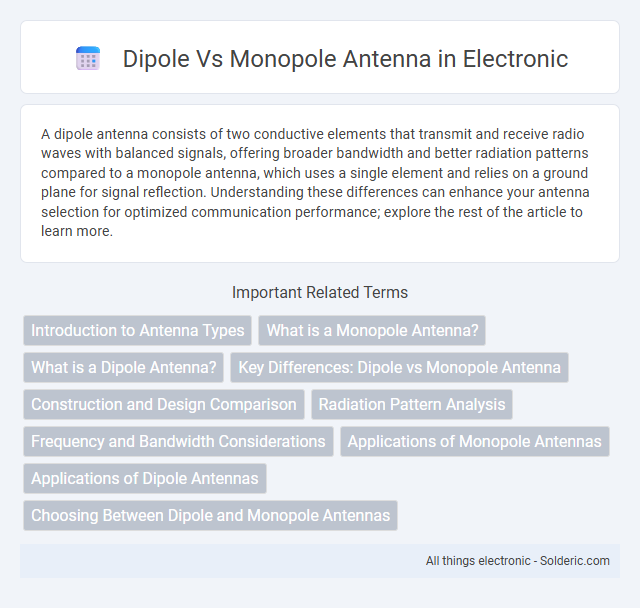A dipole antenna consists of two conductive elements that transmit and receive radio waves with balanced signals, offering broader bandwidth and better radiation patterns compared to a monopole antenna, which uses a single element and relies on a ground plane for signal reflection. Understanding these differences can enhance your antenna selection for optimized communication performance; explore the rest of the article to learn more.
Comparison Table
| Feature | Dipole Antenna | Monopole Antenna |
|---|---|---|
| Structure | Two equal-length conductive elements | Single conductive element above a ground plane |
| Radiation Pattern | Bidirectional, figure-eight pattern | Omnidirectional in horizontal plane |
| Impedance | Typically ~73 ohms | Typically ~36.5 ohms |
| Size | Full wavelength (~l/2 elements) | Half the dipole size (~l/4 element) |
| Ground Plane Requirement | Not required | Essential for operation |
| Use Cases | Balanced transmission lines, HF applications | Mobile, vertical communication, limited space |
| Polarization | Linear | Linear |
| Bandwidth | Moderate | Wide (with proper design) |
Introduction to Antenna Types
Dipole antennas consist of two conductive elements that transmit or receive radio waves by creating an electric field between them, commonly used in various communication systems for their balanced radiation pattern. Monopole antennas employ a single conductive element mounted above a ground plane, utilizing the ground as a reflective surface to produce an omnidirectional radiation pattern, often favored in mobile and broadcasting applications. Both antenna types differ in structure and radiation characteristics, influencing their suitability for specific frequency ranges and deployment environments.
What is a Monopole Antenna?
A monopole antenna is a type of radio antenna consisting of a single conductive element, often a metal rod or wire, mounted perpendicularly over a conductive ground plane, which acts as a reflective surface to form the other half of the antenna. Unlike dipole antennas that have two symmetrical elements, monopole antennas operate using the ground plane to create an image antenna, effectively doubling the radiation pattern while occupying less physical space. Monopole antennas are commonly used in mobile communication, broadcasting, and radio frequency applications due to their simplicity, compact size, and omnidirectional radiation characteristics.
What is a Dipole Antenna?
A dipole antenna consists of two conductive elements, usually metal rods or wires, arranged in a straight line with the transmitter or receiver connected at the center. It operates by creating an oscillating electric field between the two elements, which radiates radio waves efficiently in a broadside direction perpendicular to the antenna. Compared to monopole antennas, dipole antennas have balanced currents and typically offer a more uniform radiation pattern, making them ideal for various communication applications.
Key Differences: Dipole vs Monopole Antenna
Dipole antennas consist of two equal conductive elements producing a bidirectional radiation pattern, while monopole antennas have a single element mounted over a ground plane, creating a unidirectional pattern. The dipole antenna typically requires twice the length of a monopole for the same frequency due to its full-wave structure. Your antenna choice affects signal coverage and gain, making dipoles ideal for balanced radiation and monopoles preferred when ground space is limited.
Construction and Design Comparison
A dipole antenna consists of two conductive elements, typically metal rods or wires, arranged symmetrically with a feed point in the center, allowing balanced current distribution. In contrast, a monopole antenna uses a single conductive element mounted perpendicularly over a conductive ground plane, which acts as a mirror to form the image element. The design of dipoles facilitates broad bandwidth and radiation patterns, while monopoles offer a more compact structure with simpler installation but rely heavily on the ground plane quality.
Radiation Pattern Analysis
Dipole antennas exhibit a bidirectional radiation pattern with a figure-eight shape in the azimuth plane, providing strong signal strength perpendicular to the antenna axis and nulls along its length. Monopole antennas create an omnidirectional radiation pattern in the horizontal plane by radiating energy uniformly around the antenna, but with reduced gain compared to dipoles due to the ground plane's influence. Your choice between dipole and monopole antennas should consider the desired coverage area and directionality requirements for optimal signal propagation.
Frequency and Bandwidth Considerations
Dipole antennas typically offer a narrower bandwidth compared to monopole antennas, which can affect their frequency range suitability. Monopole antennas, being a quarter-wavelength structure above a ground plane, often provide broader bandwidth and better impedance matching over a wider frequency spectrum. Frequency selection for dipole or monopole antennas depends on application requirements, with monopoles favored in broadband or multi-frequency systems and dipoles used for specific, narrowband operations.
Applications of Monopole Antennas
Monopole antennas are extensively used in mobile communication devices, including smartphones and tablets, due to their compact size and efficient omnidirectional radiation pattern. They are commonly employed in vehicle-mounted systems, such as car radios and GPS receivers, where ground plane availability enhances signal strength and reliability. Their simple design makes monopole antennas ideal for applications in wireless sensor networks, RFID systems, and base stations requiring broad coverage areas.
Applications of Dipole Antennas
Dipole antennas are widely used in applications such as television and radio broadcasting, where their balanced design ensures efficient transmission and reception of signals. These antennas are also essential in wireless communication systems, including mobile phones, Wi-Fi routers, and ham radios, due to their simple construction and omnidirectional radiation pattern. In radar and satellite communication systems, dipole antennas serve as fundamental elements for array configurations, enhancing signal strength and directivity.
Choosing Between Dipole and Monopole Antennas
Choosing between dipole and monopole antennas depends on the application, frequency range, and available space. Dipole antennas offer balanced radiation patterns and typically require more space, making them suitable for higher frequencies and open areas. Monopole antennas, compact and easier to install, provide omnidirectional coverage when mounted over a ground plane, ideal for mobile and limited-space environments.
dipole vs monopole antenna Infographic

 solderic.com
solderic.com